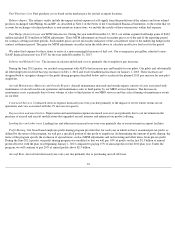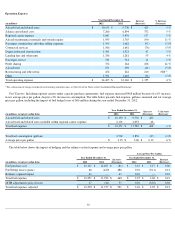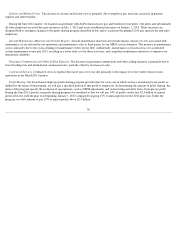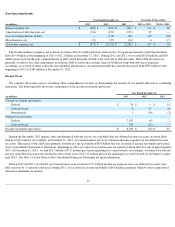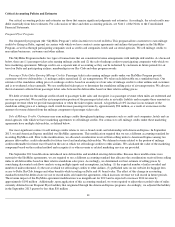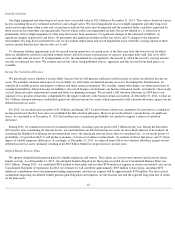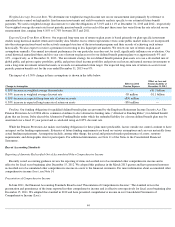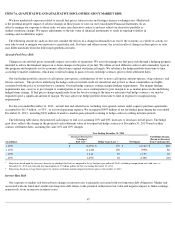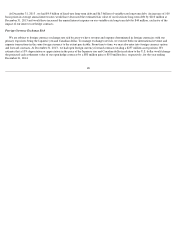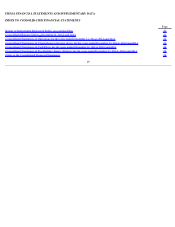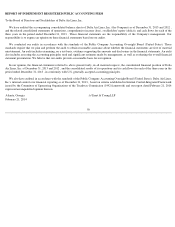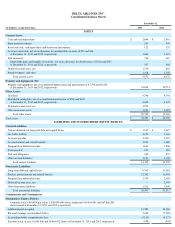Delta Airlines 2013 Annual Report Download - page 48
Download and view the complete annual report
Please find page 48 of the 2013 Delta Airlines annual report below. You can navigate through the pages in the report by either clicking on the pages listed below, or by using the keyword search tool below to find specific information within the annual report.
Breakage. For mileage credits that we estimate are not likely to be redeemed (“breakage”), we recognize the associated value proportionally
during the period in which the remaining mileage credits are expected to be redeemed. Management uses statistical models to estimate breakage
based on historical redemption patterns. A change in assumptions as to the period over which mileage credits are expected to be redeemed, the
actual redemption activity for mileage credits or the estimated fair value of mileage credits expected to be redeemed could have a material
impact on our revenue in the year in which the change occurs and in future years. At December 31, 2013 , the aggregate deferred revenue
balance associated with the SkyMiles Program was $4.4 billion . A hypothetical 1% change in the number of outstanding miles estimated to be
redeemed would result in a $28 million impact on our deferred revenue liability at December 31, 2013 .
Goodwill and Indefinite-Lived Intangible Assets
We assess our goodwill and indefinite-lived intangible assets under a qualitative or quantitative approach. Under a qualitative approach, we
consider many market factors, including those listed under Key Assumptions below. We analyze these market factors to determine if events and
circumstances have affected the fair value of goodwill and indefinite-lived intangible assets. If we determine that it is more likely than not that
the asset value may be impaired, we use the quantitative approach to assess the asset's fair value and the amount of the impairment. Under a
quantitative approach, we calculate the fair value of the asset using the Key Assumptions listed below. If the asset's carrying value exceeds its
fair value calculated using the quantitative approach, we will record an impairment charge for the difference in fair value and carrying value.
When we evaluate goodwill for impairment using a quantitative approach, we estimate the fair value of the reporting unit by considering
market capitalization and other factors. When we perform a quantitative impairment assessment of our indefinite-lived intangible assets, fair
value is estimated based on (1) recent market transactions, where available, (2) a combination of limited market transactions and the lease
savings method for certain airport slots (which reflects potential lease savings from owning the slots rather than leasing them from another
airline at market rates), (3) the royalty method for the Delta tradename (which assumes hypothetical royalties generated from using our
tradename) or (4) projected discounted future cash flows (an income approach).
Key Assumptions. The key assumptions in our impairment tests include (1) our projected revenues, expenses and cash flows, (2) an estimated
weighted average cost of capital, (3) assumed discount rates depending on the asset and (4) a tax rate. These assumptions are consistent with
those hypothetical market participants would use. Since we are required to make estimates and assumptions when evaluating goodwill and
indefinite-lived intangible assets for impairment, the actual amounts may differ materially from these estimates. In addition, we consider the
amount the intangible assets' fair value exceeded their carrying value in the most recent fair value measurement using a quantitative approach.
Changes in certain events and circumstances could result in impairment. Factors which could cause impairment include, but are not limited
to, (1) negative trends in our market capitalization, (2) an increase in fuel prices, (3) declining passenger mile yields, (4) lower passenger
demand as a result of a weakened U.S. and global economy, (5) interruption to our operations due to a prolonged employee strike, terrorist
attack, or other reasons and (6) changes to the regulatory environment.
We assessed each of the above assumptions in our most recent impairment analyses. The combination of our most recently completed annual
results and our projected revenues, expenses and cash flows more than offset the impact of fuel prices and other airline input costs. The
stabilizing operating environment for U.S. airlines has resulted in annual yields increasing along with load factors, leading to improved financial
results.
Goodwill. Our goodwill balance was $9.8 billion at December 31, 2013 . We determined that there was no indication that Goodwill was
impaired based upon our qualitative assessment of all relevant factors, including applicable factors noted in " Key Assumptions " above.
Identifiable Intangible Assets. Our identifiable intangible assets had a net carrying amount of $4.7 billion at December 31, 2013 . Indefinite-
lived assets are not amortized and consist primarily of routes, slots, the Delta tradename and assets related to SkyTeam and collaborative
arrangements.
In 2013, we determined that there was no indication that our indefinite-lived intangible assets were impaired based upon our assessments.
These assessments included analyses and weighting of all relevant factors, including the significant inputs and key assumptions which impact the
fair value of our indefinite-lived intangible assets.
42



